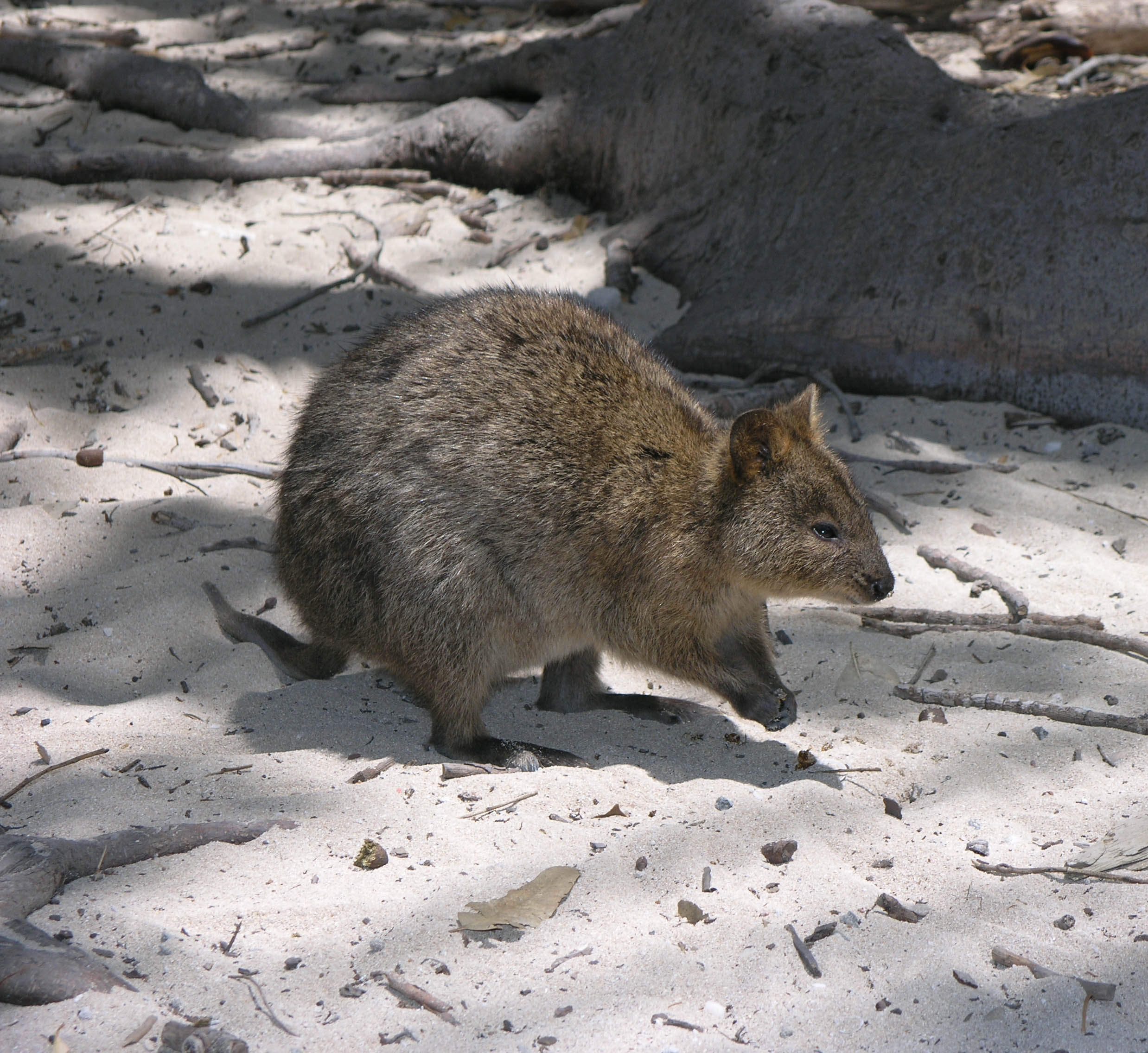- Quokka
Taxobox
name = Quokka
status = VU
trend = decreasing
status_system = iucn3.1
status_ref = IUCN2008 | assessors =de Tores, P., Burbidge, A., Morris, K. & Friend, T.| year = 12008 | id = 20165 | title = Setonix brachyurus | downloaded = 11 October 2008 VU B1ab(ii,iii) ver 3.1]

regnum =Animal ia
phylum = Chordata
classis =Mammal ia
infraclassis =Marsupial ia
ordo =Diprotodontia
familia =Macropodidae
subfamilia =Macropodinae
genus = "Setonix"
genus_authority = Lesson, 1842
species = "S. brachyurus"
binomial = "Setonix brachyurus"
binomial_authority = (Quoy & Gaimard, 1830)The Quokka ("Setonix brachyurus"), the only member of the genus "Setonix", is a small
macropod about the size of a large domestic cat.MSW3 Groves|pages=69] Like othermarsupial s in the macropod family (such as thekangaroo s and wallabies), the Quokka is herbivorous and mainly nocturnal.Ecology
In the wild, its roaming is restricted to a very small range in the South-West of Western Australia. The Quokka has become rare, but remains a protected species on islands off the coast of that area,
Bald Island ,Rottnest Island , Garden Island and rarely Penguin Island. The islands are free of foxes and cats. On Rottnest Island, it is common and occupies a wide range of habitats, ranging from semi-arid scrub to cultivated gardens.Description
It weighs 2.5 to 5 kg and is 40 to 54 cm long with a 25 to 30 cm tail — which is rather short for a macropod. It has a stocky build, rounded ears, and a short, broad head. Although looking rather like a very small, dumpy kangaroo, it can climb small trees and shrubs. Its coarse fur is a grizzled brown colour, fading to buff underneath. The Quokka recycles a small amount of its waste products.
Behaviour
The Quokka is gregarious and gathers in large groups where food is available: primary items are grasses, sedges, succulents and foliage. The health of some animals has suffered significantly by the ingestion of inappropriate foods, such as bread, given by well meaning visitors to Rottnest Island. Visitors are now asked to refrain from feeding them. It breeds at any time on the mainland, but in late summer on Rottnest. The Quokka only produces a single joey in a year. Restricted availability of the trace element
copper appears to be a major limiting factor of the ability of the Quokka to breed on Rottnest.The Quokka's movements are similar to a kangaroo, using mixture of small and large hops.
Interaction with humans
The Quokka has no fear of humans and it is common for it to hop up close enough to humans, particularly on Rottnest Island. It is, however, illegal for members of the public on Rottnest Island to handle the animals in any way. An infringement notice carrying a A$100 fine can be issued by the Rottnest Island Authority for such behaviour. [Rottnest Island Regulations 1988 (WA), rr 40 & 73; sched. 4] However, prosecution of the offence can result in a fine of up to $1000. [Rottnest Island Regulations 1988 (WA), r 40] Such fines are implemented in the rare cases that Quokkas are abused or killed by visitors to Rottnest. [ [http://www.telegraph.co.uk/news/main.jhtml?xml=/news/2003/01/12/wquok12.xml " Rare marsupials kicked to death in 'quokka soccer'"] , "
The Daily Telegraph ", 2003]tatus
Although numerous on the small offshore islands, it has a very restricted range and is classified as vulnerable. On the mainland, where it is threatened by introduced predatory species such as foxes, it requires dense ground cover for refuge. This refuge and habitat has been taken away from the Quokka by agricultural development, and this has contributed to the decline of the Quokka as well. Introduced cats and dogs, as well as dingoes, have contributed to the problem, as has the clearing and burning of the remaining swamplands.
European discovery
The Quokka was one of the first Australian mammals seen by Europeans. The Dutch mariner Samuel Volckertzoon wrote of sighting "a wild cat" on Rottnest Island in 1658. In 1696
Willem de Vlamingh mistook them for rats and named the island "Rottenest", Dutch for "rat nest".Name
The word "quokka" is derived from a Nyungar word, which was probably "gwaga". [cite book |author=Dixon, R.M.W.; Moore, Bruce; Ramson, W. S.; Thomas, Mandy |year=2006 |title=Australian Aboriginal Words in English: Their Origin and Meaning |edition=2nd ed. |location=Oxford |publisher=Oxford University Press |isbn=0-19-554073-5]
References
External links
*ARKive - [http://www.arkive.org/species/GES/mammals/Setonix_brachyurus/ images and movies of the quokka "(Setonix brachyurus)"]
Wikimedia Foundation. 2010.
